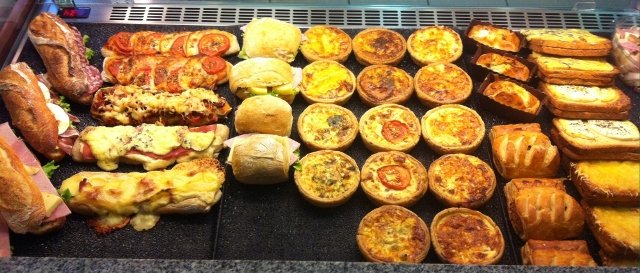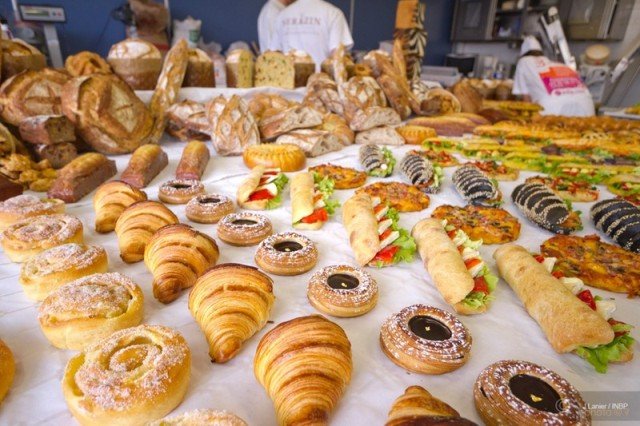The blog of cooking-ez.com

This is a question that you may well have asked yourself and which I will attempt to answer. In France the two trades of “boulangerie” (bakery) and “pâtisserie” (patisserie and confectionery) have always been quite distinct, but where exactly do the boundaries lie?
If you were to ask any baker, they would be likely to give you a one-word answer: fermentation.
It’s true that this sums it up well: the bread baker always works with fermented doughs made with yeast or leaven (sometimes called “leavened” doughs). These need time to rest and rise, often for many hours, and acquire particular flavours in the process. Mastery of this fermentation or “proving” – which takes a lifetime to acquire, according to one prize-winning artisan – is the baker’s trademark, the expression of his or her know-how and skill.
Fermentation is used for bread, of course, but also for the items known as “viennoiseries” (Viennese pastries): french croissants, chocolate rolls (petits pains), brioche, Danish pasties, etc. As they are made with a leavened dough, they come into the baker’s domain. Another sideline for bakeries that has grown in importance in France in recent years is the sale of hot or cold savoury snacks such as sandwiches, quiches, pizzas, etc.

The “pâtissiers” take care of everything else – in short, all the sweet stuff: cakes, tarts, custards, chocolates, confectionery, desserts, etc. (but not ice cream – In France that’s another specialist trade). It’s worth noting in passing that there are two types of pâtissier (pastry cooks): the ones who work in patisseries (cake shops) and those who work for restaurants, who these days have taken over the all the desserts that used to be the domain of the cooks.
Boundaries are meant to be pushed, of course: it’s pretty rare to find a French bakery that doesn’t also sell cakes, possibly because there is a trained pâtissier employed, or because the baker has trained in both fields. Similarly, many patisseries sell viennoiseries.
As you can imagine, this naturally creates a certain amount of rivalry, and the corresponding stereotypes: French pâtissiers tend to see bakers as simple oafs, only good for handling 40 lb (20 kg) batches of dough. Bakers, on the other hand, look down on pâtissiers as fragile, weedy specimens, incapable of doing anything without weighing scales… And then there are the cooks who refer disparagingly to both these types as “flour-eaters”.
So, bakers are suspicious of pâtissiers who sell viennoiseries, and pâtissiers look down their noses at bakers whose windows are full of tarts or gâteaux. But this petty rivalry is probably a good thing, as it means that crossover products need to be up to scratch, excellent even, otherwise why bother buying cakes or pastries from the patisserie if the baker makes them better?
But all viennoiseries are not equal, unfortunately. It is scandalous that the emblematic French croissant, lovingly made by an artisan baker (a specialist viennoiserie baker is called a “tourier”) in a proper bread oven, often has to compete with a poor, deep-frozen imitation. Unscrupulous shopkeepers – crooks, to my mind – merely unpack them from a carton and thaw them before selling to the unwary, in spite of a legal requirement to state that they are not “made on the premises”. Yes, I know, I’m ranting. But it matters: this sad state of affairs is depressing for bakers and devalues their trade – why bother working hard, even employing others, when industrial croissants can simply be thawed on demand? And consumers are being hoodwinked into believing that they are paying for the genuine artisan product.
On a happier note, maybe all is not lost. Here is a display showing what real bakers are still capable of:

I’ll finish by setting you a riddle: Why do wine, bread and cheese go so well together?
Answer: Because they’re all produced by fermentation.
Last modified on: February 7th 2017
(function(d, s, id) {
var js, fjs = d.getElementsByTagName(s)[0];
if (d.getElementById(id)) return;
js = d.createElement(s); js.id = id;
js.src = “http://connect.facebook.net/en_EN/sdk.js#xfbml=1&version=v2.10”;
fjs.parentNode.insertBefore(js, fjs);
}(document, ‘script’, ‘facebook-jssdk’));
Source link